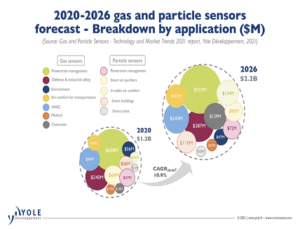
Vehicles still use most gas sensors. Moreover, the consumer market is accelerating the digitalization of smell
“The quality of the air we breathe remains a major global issue for the health and safety of people. The World Health Organization links 4.2 million deaths per year to pollution issues and exposure to toxic or dangerous gases. The cost of pollution is also a significant economic impact. The World Bank estimates it to be 4.8% of global GDP.” asserts Jérôme Mouly, Team Lead Analyst, Sensing & Actuating at Yole Développement (Yole).
But outdoor pollution is not the only concern today. Growing interest in indoor air monitoring has been amplified by the COVID-19 pandemic. Studies have shown correlations between the presence of exhaled aerosols of micro-droplets and the possible transmission of the virus carried by its aerosols. This fosters the need to control enclosed spaces such as classrooms, offices and public places.
In this context, Yole investigates disruptive technologies and related markets in depth, to point out the latest innovations and underline the business opportunities.
The Gas and Particle Sensors – Technology and Market Trends 2021 report contributes to identify and analyze the applications and the technologies involved. This study describes the player ecosystem and dynamics. Including market trends and forecasts, supply chain, technology trends, technical insights and analysis, this report also deliversan in-depth understanding of the ecosystem and main players’ strategies.
What are the economic and technological challenges of the gas and particle sensors industry? What are the key drivers? Who are the suppliers to watch, and what innovative technologies are they working on?
Yole presents today its vision of the gas and particle sensors industry.
As analyzed by Yole’s sensing & actuating team, environmental sensors, such as gas sensors and particle sensors, are more and more interesting in areas of indoor air management.
In total, gas and particle sensors are expected to be worth US$2.2 billion in 2026, up from US$1.2 billion in 2020, with a CAGR of 10.9%.
For Dimitrios Damianos, PhD, Technology & Market Analyst at Yole: “The very established automotive powertrain, industrial and HVAC markets still dominate, generating around 80% of gas and particle sensor sales. But consumer applications seem finally ready to take off, thanks to the development of smart home and wearables”…
- To read the full story, please click: Gas and particle sensors: a $2.2B market in 2026

















